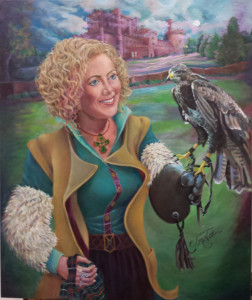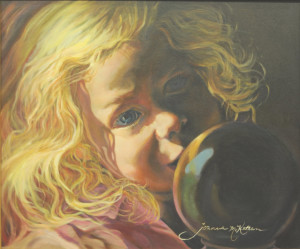From Inside the Studio, Acrylics Day
Painting with acrylics does not require a silver brush, but do be sure you don’t go el cheapo when you buy brushes. You don’t want to forever be picking hairs out of your wet acrylic masterpiece in the less than 10 minutes you have to work on it before that paint stroke dries. You can buy all sorts of shapes for your brushes if you want to, but you’ll always be looking for that perfect little square to pull down a stripe with one stroke or make a squarish something, to slide the wonderful straight edge straight along an edge for a perfect straight line. All who are resistant to painting always quote that old adage, “I can’t draw a straight line.” Don’t mess with me, they are saying. I’m not gifted like you, they actually tell you. Oh? Put out paints. Dip squared off brush into some paint color, Place on canvas, drag straight across with the edge. It worked, didn’t it? So sorry to prove you can paint a line. One further tip on that is to push up to the line, never float over it, which roughs it with additional color. Just keep all the color underneath the edge, and it can’t hop up there to mess it up.
Plant, or mash, as we Southerners say, your square-edged brush upon the edge and drag.
Again. Don’t hold it up in the air this time; we’re not looking for a pencil line, we’re looking for a straight edge under which is paint in a random shape. From this point on, just lather it on below and up to the wet random paint (but never all the way back up to the edge where you will likely mess up what you already had perfect) until you get to the next edge or the end of your passage. You can use just the square edge for a very small point, if you need it, but for the straight edge, match brush edge to edge to be painted. I am being tedious only because I have had to continue in this exact fashion with my students. It isn’t that we are dumb, it is that we have been taught that painting is hard, and we miss the obvious, sometimes.
You can use the same motions (for ladies) that you use for putting on your makeup, soft curving strokes (once you have the edge), some lightly feathered over the thicker ones to connect newer, different colors together seamlessly. Work as long as the paint will let you and you feel you need to. Don’t mindlessly dab. Dabs aren’t strokes, and what are you doing? Do you know the goal for all that dabbing? What was wrong with it the way it was first laid down? You don’t know? Well, then, stop. Another cautionary. Don’t keep pulling paint into new, dry areas from where you put the wet paint down. You are thinning it, and making it worse, not better. Do the logical brushing for the amount of paint you have, stop, and dip your brush in more paint. Feather the add-on into the old lightly, because by now it is drying and has lost its ability to give. Let the old part rest and dry, continue with the wet. If, heaven forbid, you go back over it with watered acrylic, you might lift up a hole, a whole patch of paint that leaves a hole. That is the number one worst error to make, I’m telling you. Can’t correct it, it will leave a bumpy edge all around the hole.
Did we say acrylic is dimensional paint? That means the paint itself builds up and has thickness to it. Oh, Well. You can sand it down and start again.
There are those who like to trip along the bumps of the canvas and spread a little paint here, a little paint there, leaving dry patches in-between. This strategy is not a good one. How do you ever find all those little squares you missed to patch over them? You have to, you know, because unlike watercolor, where bits of paper showing through is considered beautiful, bits of patterned canvas are considered ugly. Now I know some exception will raise it’s beautiful head to prove me wrong. That’s okay. But skipping along with a dry brush has just made your work needlessly more tedious. Just like making a tedious drawing akin to paint-by-numbers drawings with the eyelashes drawn in. And you’re supposed to paint between the eyelashes? I’m sorry, but you must use your noggin, here, and paint in large areas, colors, and surfaces, first. You can’t work from detail down, even if it does anchor you. You have to subtract detail and work with big shapes up.
Check around. Everybody’s saying it.
Now, if you didn’t do this to begin with, try it with your next one. Plan your layout of your canvas, your composition as it’s called, ahead of time. See if you can’t divide it into seven basic shapes. Now you’re cooking with gas. Allrightee, then. Into or onto those seven sections, if you will, you can further subdivide after you’ve painted the main color. All this, and we haven’t even come to modeling. Modeling is a real pain in acrylic. I’ll just say it exactly like it is. Acrylic lends itself to bold contrasts better than slight changes from dark green to lighter, for instance, being as how the paint dries so fast, and you will go back and forth like I’ve seen all my students do, thereby flattening the passage of paint instead of modeling it. You can try slight increments in color, increase of dark (darker color added), or increase of white added into it, lighter, pick one, don’t try both, and feather the edge over the older, drying color.
The toll-painting method of striation of color or variegating it is actually a good strategy. This is called double or triple-loading your brush with 2 or 3 different colors of paint. Don’t glob it all together, space the colors out as you pick them up off your palette. Then apply in short strokes for hair or grass, for instance, re-load, repeat. If you make your strokes too long, the grass will turn to weeds and the horses’ hair to a shaggy, strange breed. Think how hair is actually done on your head, in overhanging layers.
Now, then, I’ve taken you way beyond your limits for today, telling tales and jokes to lighten the seriousness of doing acrylic painting. No matter how serious our intents are, we won’t get there without funnies and breathers and laughing at ourselves and our teachers a little bit. That’s right, you can laugh at me, too. I can help because I’ve made all these mistakes at least once. Don’t be afraid of making mistakes, or too sensitive about it. That slows you up so much and makes you hard to get along with. It’s not that big a deal. You can paint over what you did, too. When I say that, you don’t have to paint over everything. Just the things you think are bad wrong. It’s better to leave some paint alone and go from where you were. New starts make new mistakes. When layering in acrylic, make sure your under layer is bone dry first.
Thank you for reading my eBook, Acrylic Painting Techniques Easy(ier). link I try to break it down to its simplest components for easy access. I can complicate anything, so if you have questions to help me complicate the matter, just ask!
Learn more »





 , so I decided to try my hand at making my current painting look like the cover for a book, and based on my success or not with that, I might try it. I studied my social media friend’s work and extracted some good pointers. They were not copycat observations, but they were stylistic touches which pulled the eye always toward the center.
, so I decided to try my hand at making my current painting look like the cover for a book, and based on my success or not with that, I might try it. I studied my social media friend’s work and extracted some good pointers. They were not copycat observations, but they were stylistic touches which pulled the eye always toward the center.
 al attack.
al attack.